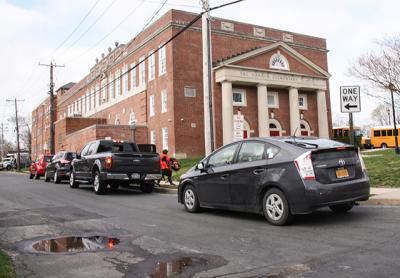More Staff, More Cars

New Sag Harbor regulations banning parking on side streets near the village’s two schools may be the village board’s way of encouraging the school district to provide more parking on its own, but some are concerned that the laws could impact safety, as well as local businesses.
Sag Harbor schools occupy two buildings. The elementary school is on the corner of Hampton Street (Route 114) and Clinton Street. Pierson Middle-High School is off Jermain Avenue, between Montauk Avenue and Division Street. On Dec. 13, 2016, the village board resolved to prohibit parking, mainly during school hours, on some of the nearby residential streets, prompted, according to the mayor, by safety concerns.
Parking was eliminated on Clinton Street, and prohibited between 8 a.m. and 4 p.m. on both sides of Montauk Avenue, the west side of Hamilton Street, the west side of Ackerly Street, and the south side of Elizabeth Street. Enforcement began on Monday as students returned from spring break.
On Tuesday afternoon, Dr. John French, a dentist who lives and works on Hampton Street, said the new regulations were already causing him problems. “Now, during the drop-off and pick-up, it’s almost impossible to get a spot here,” he said. Hampton Street parking is packed in both directions, he said, and his wife could not come home.
His driveway can fit three cars, but he has six employees and sees some 30 patients a day, starting at 8 a.m. He recently purchased a practice and will soon have up to nine on staff, he said. Dr. French starts seeing patients at 8 a.m.
He bought his house in 2004 from a family practitioner, who had paid $20,000 for a “home professional” permit meant to facilitate parking, he said. “Do I get my $20,000 back?” he asked.
On April 11, during the village board’s regular monthly meeting, Dr. French voiced his concern. “I’m going to lose half my business for this,” he said, explaining that Ackerly Street was where many of his patients used to park.
Ed Deyermond, a member of the village board who lives on Ackerly, said Dr. French had a valid point, but that the village had to do something about congestion from school-related traffic. The district does not provide enough spots for its employees, he said. “You can’t get vehicles up Ackerly Street. The school has to step up. I’m surprised no child or parent or grandparent hasn’t been hit on Clinton Street . . . we’ve been talking about this for years, and what’s happened? Nothing.”
Mr. Deyermond said he understood from school officials that 30 percent of eligible students take the school bus. During drop-off and pick-up, he said, “the traffic is backed up from the school down 114, north down 114, down to Madison Market — I’m showing my age here — almost to Bulova.”
Late last week, school district officials met with village board members and the police chief. “I’m certain they would have liked us to roll back the restriction,” said Mr. Deyermond, adding that district officials indicated they would appoint a committee to look at the matter. Crosswalks and sidewalk improvements in a half-mile radius of the school were discussed as well.
As for traffic, Mr. Deyermond said it was already flowing better under the new regulations.
The new law is “not going to make the cars disappear,” said Ken Yardley, the owner and funeral director at Yardley and Pino Funeral Home, which is across the street from the elementary school. “It’s only going to cause them to park on another street. Where they end up might not be a good place either.”
His business, with visiting hours for the departed usually occurring between 2 and 4 and 7 and 9 p.m., will be affected only during the afternoon hours. The funeral home has been there since 1932, but the hustle and bustle around the school has grown over the decades. Mr. Yardley said he understood the village’s safety concerns, but “you still have to put the cars somewhere.”
The school district, he said, has to do something to alleviate the congestion, and he suggested that buying property to create a parking lot somewhere was the best answer. “If they had a 40-car parking lot, that’s 40 less cars out on the street.”
